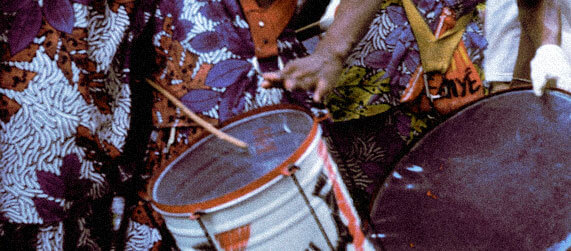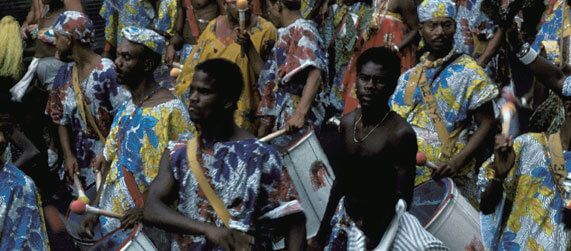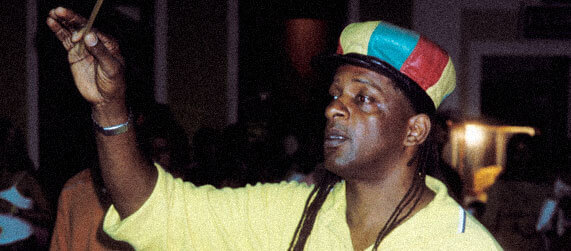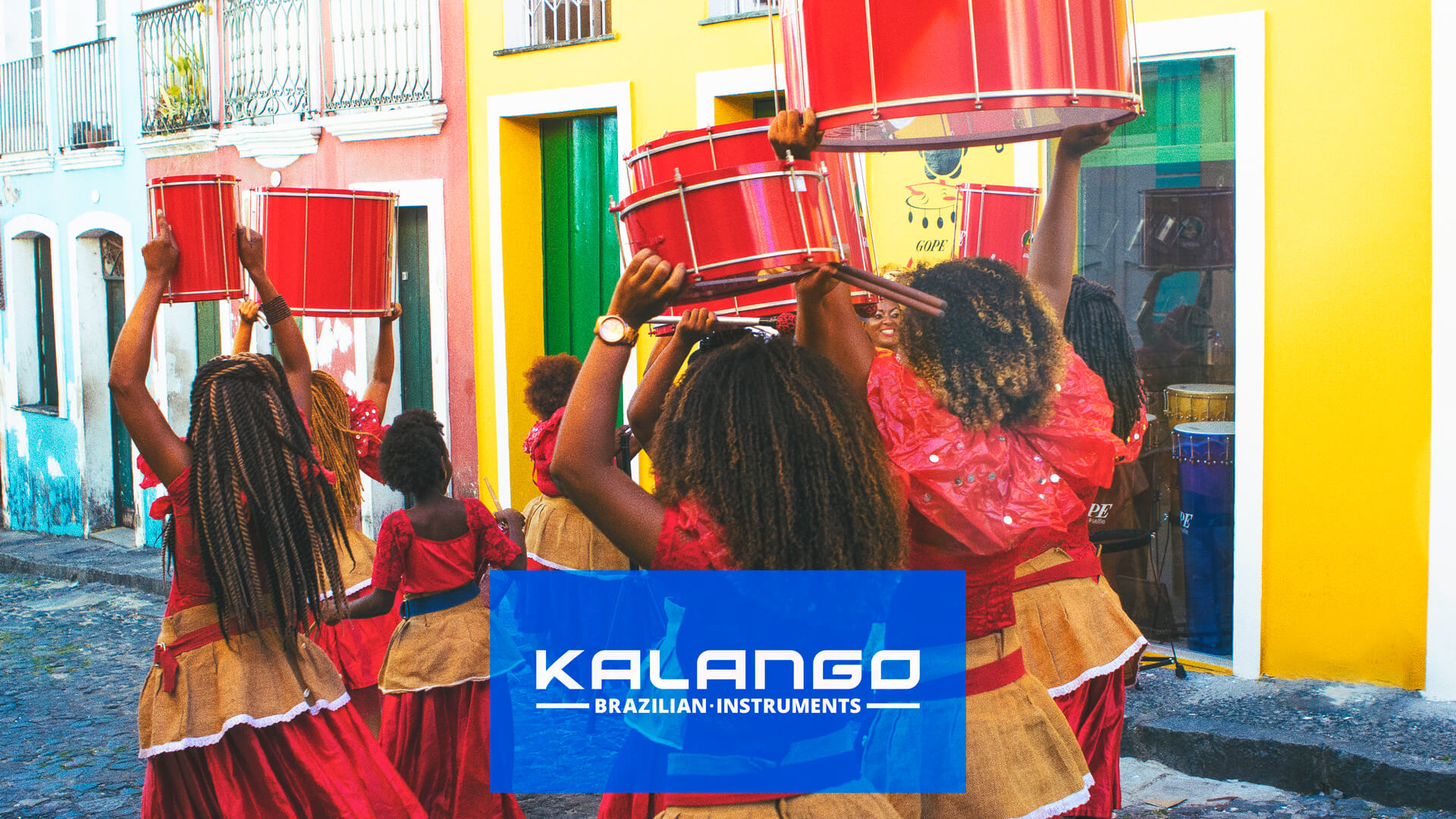Bahia Styles
What is an Afro Bloco?
The expression Afro Bloco embraces various styles from Bahia, probably the most common ones are the Afoxé, Samba Reggae, Afro Samba and Timbalada. A Bloco is what people in Salvador call a carnival association, which actively participates with its members in the carnival parades.
An Afro Bloco is the name for those groups whose members are by the majority or exclusively coloured and who committed themselves to the African heritage.
On the streets of Salvador da Bahia there´s loads of percussion groups of all kinds of different styles - not only at carnival! The Samba Reggae of Olodum is probably the most popular one. Much closer to tradition you will find Ilê Ayê´s Afro Samba. The Afoxés bring the music from the Candomblê - the Afrobrazilian religion, to the streets. Everybody probably knows the Afoxé group Filhos de Gandhy. Carlinhos Brown created a style completely of their own. Timbalada considers itself as a bloco of all human beings, without being influenced by ancestry or race (somos um bloco para todos os seres humanos). The other groups can be gathered under the expression afro bloco.

Till 1974
Although the coloured population has been the majority of Salvador for the last couple of centuries, the carnival has been determined by the white upperclass until the seventies. During the carnival, the white carnivalesc associations dominated with magnificent parades and ostentatiously glorious balls. Protests by the coloured habitants were cut off or in the best of the cases was tolerated. There were several attempts of the black population to create their own participating carnival groups, like for example in 1949, when some dockworkers met up and founded the Afoxé Filhos de Gandhy. Nevertheless, such activities remained the exception.

From 1974
Only since Ilê Ayê´s first formation in 1974, the black poplulation managed to slowly archieve more presence in the carnival. Ilê Ayê was founded in Liberdade, a neighbourhood in Salvador with almost only black habitants. A large inspiration for them was the Black Power Movement in the US. This was the beginning of the search for a new black consciousness and a new black identity. When they first appeared in public at a carnival, dressed in african costumes with the rhythms of the drums, it was a complete scandal. But their seeds fell on fertile ground: Quickly more and more black carnival groups developed.

From 1974 to the early 1990s
In 1979 Olodum and Malê Debalê started with their activities, in 1980 Ara Ketu and Muzenza followed their example. The biggest achievement of the Afro Blocos throughout all Brazilian social stratums was gained when a couple of Bahian Pop-groups like Banda Reflexus and singers such as Margareth Menezes were crowned with success. Olodum´s and Ilê Ayê´s public rehearsals in the early nineties were legendary. Bit by bit the Blocos took over the carnivals. As soon as Paul Simon, David Byrne and above all, Michael Jackson started combining their music with their beats, the Afro Blocos received international attention. The new black awareness is especially visible each year during the parties which are held for celebrating the election of the Bloco´s carnival queen. People then celebrate the new beauty queen – Beleza Negra – with music and dance and live their new consciousness.
The 1990s
Timbalada is a special case. The group was founded in the early nineties and could be counted to the Afro Blocos due to its structure and presence in all sorts of social projects. Thanks to its charismatic founder and musical director Carlinhos Brown, Timbalada had very obvious characteristics of Pop music right from the beginning on and therefore is known as an own category.
Afoxé, Samba Reggae, Afro Samba and Timbalada
Afoxé
In Bahia, an Afoxé is a group that brings the tradition of Candomblé to the streets. On the parades they play the Ijexá rhythm on drums, agogôs and shekerés and sing ritual songs. Except being part of the carnival activities, the Afoxé groups also participate in other mayor festivities in Salvador: Without the Afoxés, celebrations like the Lavagem de Bonfim or the festivities for Yemanjá, godess of the Ocean, held on February 2nd each year, would be unimaginable. When the Afoxé Filhos de Gandhy fills the streets of Salvador with thousands of white-dressed people on carnival´s Sunday, the atmosphere changes all the sudden. Instead of the heavy beats and the sweeping party sound of Axé music coming from the trios eléctricos, you hear the many voiced singing accompanied by atabaques, shequerés and agogôs. The party mood is replaced by a peaceful and relaxed spirit for a couple of minutes.
Samba Reggae
Samba Reggae has its origin in Salvador da Bahia and is a rhythm that blended traditional rhythm elements of Bahian Samba and influences of the Caribbean, mainly Reggae and Merengue. Neguinho do Sambo played a central role in the process of this melange. Since the beginning of the1980s he was the musical director of Olodum. Neguinho enriched the Bahian world of rhythms by developing the relaxed flowing offbeat of the repiniques and the rolling 1/16 on the surdos. This compilation creates a very unique swing. Olodum has by far been the most popular Samba Reggae formation from Salvador within the last couple of decades. Muzenza, the other important Samba Reggae group from Salvador, was as its peak similarly popular as Olodum and celebrated a huge hit with their song „Brilho e Beleza“.
Afro Samba
Afro Samba is the melting pot of all the different types of Bahia´s Samba traditions, that transforms them to outdoor-compatible and earthy grooves. Ilê Ayê, the oldest and most popular Afro Samba group is well known for their hypnotic rhythms. The The excitement of speeding which has been an important part of Rio style Samba during the last couple of years, has not even slightly touched the drummers of neither Ilê Aiyê nor of Malê Debalê, the other big Afro Bloco. Musicians, dancers and singers refer strongly to the African roots of their culture which is also very visible in the style and aestetics of their costumes.
Timbalada
The group Timbalada was founded in 1991 by Carlinhos Brown in the Candeal hood of Salvador. Brown by then was percussionist in the bands of Luiz Caldas or Caetano Veloso. The timbal, originally played in horizontal position like a TanTan, was quickly turned in its vertical by Brown and pitched right up. Since ever the timbal is the most typical character of the band. Due to its similarity of sound range to the one of a caixa, decision was taken to leave that instrument out completely. Instead of tamborins they used tiny repiniques called bacurinhas. With this brandnew picture of a sound, Timbalada´s successful history was iniciated. The colourfully decorated instruments and musicians painted all over with white stripes and dots are until today a spectacular trademark.
Musical development of the Afro Blocos
Social activities
Right from the beginning, the activities of the Blocos were a lot more than participating in the carnival of Salvador. The aim was the development of a black consciousness, encouraged by various social projects inside their particular hood. Also the texts of the songs reflect this new awareness. The importance of the connection to the African patrimony is already set with the names of the Blocos.
All names of the Afro Blocos descend from an African idiom, mostly from the Yoruba or a Bantu language. School- and apprenticeship projects, iniciated and run by the Blocos, increased the kids´chances. The Blocos became employees for teachers in the school projects, they created employment for musicians or dancers in the bands, skilled manual and artisan work, especially tailoring, but also building instruments became new perspectives.
Musical development of the Afro Blocos
Early times
The hypnotic rhythms are played on the traditional Samba instruments. When Ilê Ayê began, there was no clear musical concept. People played rhythms which were strongly inspired by the rhythms of Bahian Samba tradition with the typical instruments they knew from the Samba schools, like repinique, caixa, surdo, tamborim, ganza and agogô. Even nowadays – if you ´re lucky – you might find some bands that have retained the anarchistic character of the early times, night-rehearsing in the Pelourinho neighborhood. You play whatever goes together well in some or the other way, different drum-techniques coexist, still the big picture is framed by a magnificent groove.
Developing
The musical directors managed to structure the rhythmic action bit by bit. Over the years this all gave rise to a very particular, characteristic style and a sound image which bacame typical for the Blocos. Within the last years, the tamborim and the agogô lost their importance and have by now almost dissappeared completely from the groups. The surdos occupy a special position. Compared to a Rio-Samba school, there are much more surdos in an Afro Bloco. Actually, you will quite often see groups that consist in more than half of surdos.
Grooves
In Europe, people identify the Blocos from Salvador by their grooves. Olodum is probably the most popular Sambareggae band, Ilê Ayê stands more for the tradition of the Sambaduro and the Samba de Roda. The kicking offbeat and the typical rolling surdos of Olodum´s grooves are nowadays the inspiration for many percussion bands all over the world and a set component of their repertory. The typical rhythms based on traditional Bahian Samba have provided many parades or parties with beautiful and colourful energy.
Songs
In Brasil, people´s attention is not so much on the grooves, but on the songs, their texts and the chorus. The Blocos´songs, especially those by Olodum, are by now an integral part of the Bahian culture. During the gigs and parades, thousands of people join in singing along word by word . Many groups share the musical activities between their banda - their showgroup – and the bloco – the large percussion ensemble.
The banda
During important occasions of the year like the carvival or street parades, the large drum formation performs. Normally there is a massiv percussion group accompanied by various singers on a huge truck and a potent sound system, the Trio Eléctrico. In contrast to the batería, the banda consists of one ore few singers and a small selection of percussionists, often supplemented by a band with electrically amplified instruments such as bass, guitar and keyboard, which create a strong aspect of Pop music.
Up to date
Ara Ketu disbanded their bateria completely in the beginning of the nineties and then concentrated very successfully on their Showband. Olodum, Ilê Aiyê and Ara Ketu have played an endless number of gigs with their bands all over the world. However, on this path of popularisation also the content of the songs has changed. The former political and rebellious songs became less, love songs with a clear Pop music character became more and more common. Ilê Ayê is the band that managed to stay the closest to its musical roots, Olodum however can almost be counted to the Axé music, a Pop-offshoot of the Afro Blocos.







